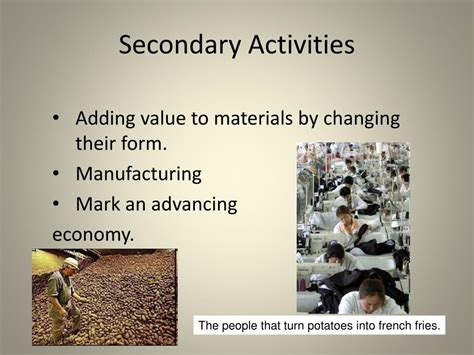Introduction

Economic activities are primarily divided into three main sectors: primary, secondary, and tertiary. Primary economic activities involve the extraction of raw materials from natural sources, such as agriculture, mining, and fishing. Secondary economic activities, on the other hand, focus on transforming these raw materials into finished goods. Understanding the role of secondary economic activity is crucial for economic growth and societal well-being.
Definition of Secondary Economic Activity
Secondary economic activity refers to the industrial processes that convert raw materials or semi-finished products into manufactured goods. It includes a wide range of industries, from basic manufacturing, such as the production of steel and textiles, to advanced manufacturing, such as the production of electronics and machinery.
Secondary industries are essential for the economic development of nations. They create employment opportunities, generate wealth, and contribute to technological advancements. They also support the primary and tertiary sectors of the economy.
Importance of Secondary Economic Activity
- Job Creation: Secondary industries employ millions of people worldwide. They provide jobs in manufacturing plants, assembly lines, and research and development facilities.
- Economic Growth: The manufacturing sector is a major driver of economic growth. By producing goods, secondary industries stimulate demand, create income, and support other sectors of the economy.
- Value Addition: Secondary industries add value to raw materials by transforming them into finished products. This process creates economic value and increases the overall productivity of an economy.
- Technological Innovation: Secondary industries are often at the forefront of technological innovation. They invest in research and development to improve manufacturing processes, develop new products, and enhance efficiency.
- Export Earnings: Manufactured goods are major export commodities for many countries. Exports generate foreign exchange, create jobs, and boost economic growth.
Benefits of Secondary Economic Activity
- Improved Standard of Living: Manufacturing industries produce goods that consumers need and desire. These goods contribute to a higher standard of living by providing access to essential products, appliances, and technological advancements.
- Increased Productivity: Secondary industries introduce automation, robotics, and other technologies that increase production efficiency and reduce costs. These productivity gains translate into lower prices for consumers and higher profitability for businesses.
- Environmental Sustainability: Advanced manufacturing techniques can reduce waste, conserve energy, and minimize environmental impact. This contributes to a more sustainable economy and protects the environment.
- National Security: A strong manufacturing sector is essential for national security. It provides the ability to produce essential goods, such as military equipment and medical supplies, domestically.
- Social Impact: Secondary industries create social benefits by providing jobs, improving living standards, and fostering community development.
Common Mistakes to Avoid
- Overdependence on Primary Industries: Relying too heavily on primary industries can limit economic diversification and make economies vulnerable to fluctuations in commodity prices.
- Lack of Investment in Innovation: Failing to invest in research and development can stifle manufacturing growth and lead to technological stagnation.
- Inefficient Production Processes: Outdated equipment and inefficient processes can reduce profitability and make it difficult for businesses to compete in global markets.
- Environmental Degradation: Ignoring environmental regulations and practices can harm ecosystems, reduce productivity, and damage the reputation of manufacturing industries.
- Unfair Labor Practices: Exploitative labor practices, such as low wages, poor working conditions, and child labor, can undermine the social benefits of manufacturing and damage the industry’s reputation.
Strategies for Enhancing Secondary Economic Activity
- Invest in Education and Skills Development: A skilled workforce is essential for a thriving manufacturing sector.
- Encourage Innovation and Entrepreneurship: Support research and development, provide tax incentives, and foster a culture of innovation.
- Adopt Best Practices and Automation: Modernize production processes, introduce robotics and automation, and optimize supply chains.
- Promote Sustainable Manufacturing: Implement green technologies and practices to reduce waste, conserve energy, and protect the environment.
- Provide Infrastructure and Logistics: Develop transportation networks, energy infrastructure, and efficient logistics systems to support manufacturing.
Conclusion
Secondary economic activity is a cornerstone of economic development. It transforms raw materials into finished goods, creates jobs, generates wealth, and supports the primary and tertiary sectors. By investing in education, innovation, best practices, and sustainable manufacturing, countries can enhance the competitiveness and benefits of their secondary economic activities.
